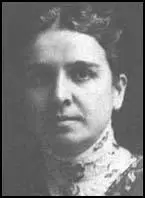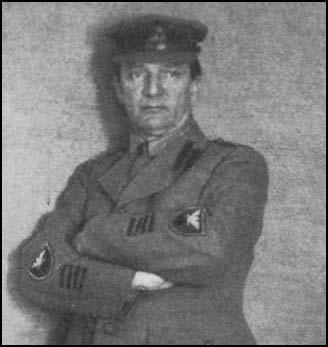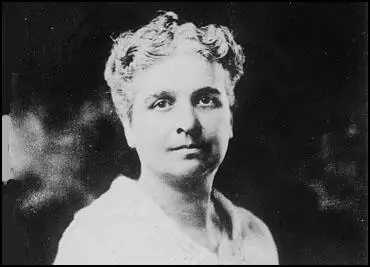Margaret Dreier Robins

Margaret Dreier was born in Brooklyn on 6th September, 1868. Her father, Theodor Dreier, had arrived in the United States from Bremen, Germany, in 1849. He settled in New York City and eventually became a partner in an important iron company. Dreier married his cousin, Dorothea Dreier, in 1864, and the couple had four daughters. Margaret, Dorothea Dreier (1870-1923), Mary Dreier (1875-1963) and Katherine Dreier (1877-1952).
Margaret attended George Brackett's School in Brooklyn Heights but none of the children were allowed to go to college. As a young woman she suffered from severe migraines and in 1894 was diagnosed as suffering from a "strained heart", a malady that brought with it fatigue, anxiety and depression. Unable to leave the home, she spent much of her time reading and was greatly influenced by the work of Ralph Waldo Emerson. At the age nineteen, she began doing charity work at Brooklyn Hospital and soon became involved in other progressive causes. She was especially interested in women's suffrage and working conditions.
In 1902 Margaret met the social reformer Josephine Lowell, who was the leader of the Woman's Municipal League (WML). Lowell told Margaret that: "The interests of the working people are of paramount importance, simply because they are the majority of the whole people, and the indifference and ignorance and harshness felt and expressed against them by so many good people is simply awful to me and I must try and help them, if I can." Lowell also pointed out: "”If the working people had all they ought to have, we should not have the paupers and criminals. It is better to save them before they go under, than to spend your life fishing them out afterward." Margaret was convinced by Lowell's arguments and became a member of the WML.
Margaret was introduced to members of other reform groups and in December, 1904, joined the Women's Trade Union League (WTUL). The main objective of the organization was to educate women about the advantages of trade union membership. It also support women's demands for better working conditions and helped to raise awareness about the exploitation of women workers. Other members included Jane Addams, Lillian Wald, Margaret Robins, Leonora O'Reilly, Ida Rauh, Mary McDowell, Margaret Haley, Helen Marot, Mary Ritter Beard, Rose Schneiderman, Alice Hamilton, Agnes Nestor, Eleanor Roosevelt, Florence Kelley and Sophonisba Breckinridge.
In 1905 Margaret heard Raymond Robins deliver a lecture on the social gospel in a Brooklyn church. Robins was the brother of Elizabeth Robins, the famous actress, playwright and campaigner for women's rights in Britain. Margaret married Robins and for a while lived at the Hull House settlement in Chicago. Margaret and her husband were involved in providing free lectures to the local population on a wide variety of different topics.
Although her husband had progressive opinions he was strongly against socialism. His friend, William Hard , pointed out: "He was living then at a settlement in Chicago called the Chicago Commons. It had an open forum called, I think I remember, the Free Floor. On that Free Floor, and in little halls on North Clark Street, and in all sorts of other places, Robins and I heard all sorts of Bolshevik oratory in the Chicago of the early innocent twentieth century.... Raymond Robins' favorite intellectual pursuit was to go after it with all the arguments he could think of. In forums and in halls and at that earnest gathering of local truth-seekers called the Friday Lunch Club he never missed an opportunity to argue against Bolshevism and against every other form of Socialism."
are Hannah Hennessy, Ida Rauh, Mary Dreir, Mary Kenney O'Sullivan,
Margaret Robins, Margie Jones, Agnes Nestor and Helen Marot.
Margaret became a leading figure in the Women's Trade Union League and served as its president in 1907. She was also an active figure in the Progressive Party and her husband, Raymond Robins, served as chairman of the State Central Committee. Theodore Roosevelt and Hiram Johnson became the party's candidates in the 1912 presidential election. The proposed program included women's suffrage, direct election of senators, anti-trust legislation and the prohibition of child labour. In winning 4,126,020 votes Roosevelt defeated William H. Taft, the official candidate of the Republican Party. However, he received less votes than the Democratic Party candidate, Woodrow Wilson. In 1914, Robins was candidate for United States Senator from Illinois.
During the First World War her husband headed the expedition for the American Red Cross to Russia. After the abdication of Tsar Nicholas II in March, 1917, George Lvov was asked to head the new Provisional Government in Russia. Robins was a strong supporter of Alexander Kerensky, the Minister of War. Kerensky toured the Eastern Front where he made a series of emotional speeches where he appealed to the troops to continue fighting. Kerensky argued that: "There is no Russian front. There is only one united Allied front." Leon Trotsky met him during this period and described him as a "counter-revolutionary".

On 25th April, 1918, Raymond Robins had dinner with Arthur Ransome. The two men agreed that the Soviet government would survive and that Western governments should not attempt to overthrow it. Ransome argued that he had written a pamphlet with Karl Radek, entitled On Behalf of Russia: An Open Letter to America. Robins, who was just about to leave for home, agreed to use his influence to get it published by The New Republic magazine.

William Hard, the author of Raymond Robins' Own Story (1920), has argued that as a result of Robins arguing against Allied intervention in Russia in support of the White Army, he was accused of being a Bolshevik. "Today, because he opposes American and Allied military intervention in Russia, certain hasty or malevolent persons try to stamp the stigma of Bolshevism on him. I only ask: how many of those persons have ever said one word against Bolshevism where to say it was dangerous? Robins spoke against Bolshevism in Petrograd itself. He labored against Bolshevism., and is publicly recorded to have labored against it, all through the period while Russia was making its choice between Kerensky and Lenin. Robins has been consistently and continuously anti-Bolshevik, in America and in Russia; but he saw the failure of our diplomacy in Russia; and he had a chance to perceive the reason, the instructive reason.... Robins holds the view that no effort to combat Bolshevism can ever be successful unless it is directed against what Bolshevism is, instead of against what Bolshevism is not; and therefore he has first tried to describe what Bolshevism is, in its internal going power; and if people call him a Socialist for doing so, he can afford to be patient."
Margaret Dreier Robins retired from the Women's Trade Union League in 1922. The couple moved to Florida in 1925 and remained active in progressive politics until her death on 21st February 1945.
Primary Sources
(1) Jane Addams, Trade Unions and Public Duty (1899)
Let us put ourselves in the position of the striking men who have fallen upon workmen who have taken their places. The strikers have for years belonged to an organization devoted to securing better wages and a higher standard of living, not only for themselves, but for all men in their trade. They honestly believe, whether they are right or wrong, that their position is exactly the same which a nation, in time of war, takes towards a traitor who has deserted his country's camp for the enemy. We regard the treatment accorded to the deserter with much less horror than the same treatment when it is accorded to the 'scab', largely because in one instance we are citizens are participants, and in the other we allow ourselves to stand aside.
(2) Women's Trade Union League pamphlet (1909)
How would you like to iron a shirt a minute? Think of standing at a mangle just above the washroom with the hot steam pouring up through the floor for 10, 12, 14 and sometimes 17 hours a day! Sometimes the floors are made of cement and then it seems as though one were standing on hot coals, and the workers are dripping with perspiration. They are breathing air laden with particles of soda, ammonia, and other chemicals! The Laundry Workers Union in one city reduced this long day to 9 hours, and has increased the wages 50 percent.

